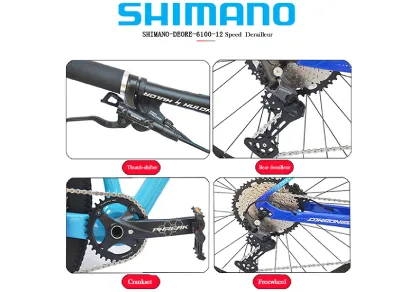8 月 . 21, 2024 06:12 Back to list
Steps to straighten a bent derailleur on your mountain bike effectively and safely
How to Fix a Bent Derailleur on a Mountain Bike
Mountain biking is an exhilarating way to enjoy the great outdoors, but it can come with its fair share of wear and tear on your bike. One common issue many riders encounter is a bent derailleur. This can happen from a fall, hitting a rock or a tree, or just through general use over time. If you're experiencing shifting issues or hearing strange noises from your drivetrain, it might be due to a bent derailleur. Fortunately, fixing a bent derailleur is a task that you can often handle at home with some basic tools and a little patience.
Diagnosing the Problem
Before you start making any adjustments, it’s crucial to diagnose the problem accurately. Begin by inspecting the derailleur closely. Look for any visible bends or misalignments. Common signs of a bent derailleur include
1. Poor shifting performance, where the chain skips or fails to shift to the desired gear. 2. The derailleur hanger is visibly tilted or bent. 3. The chain is rubbing against the derailleur's cage.
Once you’ve confirmed that the derailleur is bent, it’s time to take action.
Tools You'll Need
To fix a bent derailleur, you'll need a few tools - A 5mm Allen wrench (to adjust the derailleur and hanger). - A straight edge or a derailleur alignment tool (if available). - A pair of needle-nose pliers (for minor adjustments). - A flat surface or a bike repair stand to stabilize your bike.
Step-by-Step Repair Process
1. Secure the Bike Place your bike on a repair stand or flip it upside down to make access easier.
how to fix a bent derailleur on a mountain bike

2. Assess the Derailleur Hanger The derailleur hanger is often the culprit when it comes to alignment issues. Check if it’s bent by using your straight edge. If it looks misaligned, you might be able to gently bend it back into position using your hands or pliers. Be cautious, as too much force can cause it to snap.
3. Check the Derailleur Alignment After adjusting the hanger, check the derailleur itself. It should be parallel to the cassette. Adjust the positioning as necessary, ensuring that it doesn’t strain the chain.
4. Tighten All Components Once you’ve adjusted the hanger and derailleur, check and tighten all screws. Make sure the limit screws are appropriately set to avoid the chain from going too far in either direction.
5. Test the Shifting With everything tightened, test the shifting by cycling through the gears. Ensure that the chain moves smoothly from one cog to the next without hesitation. If you notice any grinding or skipping, further adjustment is necessary.
6. Final Adjustments If the shifting is still not perfect, minor adjustments to the limit screws or cable tension might be needed. Take small steps as you tune the derailleur to achieve optimal performance.
Preventative Measures
Once your derailleur is fixed, it’s essential to take steps to prevent future bending. Regularly inspect your bike before rides, particularly after rough trails. Invest in a quality derailleur guard, which can help provide extra protection in case of a fall or impact.
Conclusion
A bent derailleur can cause significant issues with your bike’s performance, but it’s a repairable problem. With a bit of patience and the right tools, you can restore your mountain bike to its optimal state and get back on the trails in no time. As always, if you feel uncomfortable making these adjustments yourself, it’s best to consult with a professional bike mechanic. Happy riding!
-
The Main Application Scenarios of Mountain Bike
NewsOct.29,2024
-
Suggestions for Selecting and Maintaining Mountain Bike
NewsOct.29,2024
-
Characteristics of Kids Balance Bike
NewsOct.29,2024
-
Characteristics of Baby Stroller
NewsOct.29,2024
-
Characteristics and Advantages of Mountain Bike
NewsOct.29,2024
-
Baby Stroller Purchasing Suggestions
NewsOct.29,2024
-
Suggestions for Purchasing Kids Balance Bike
NewsOct.09,2024

